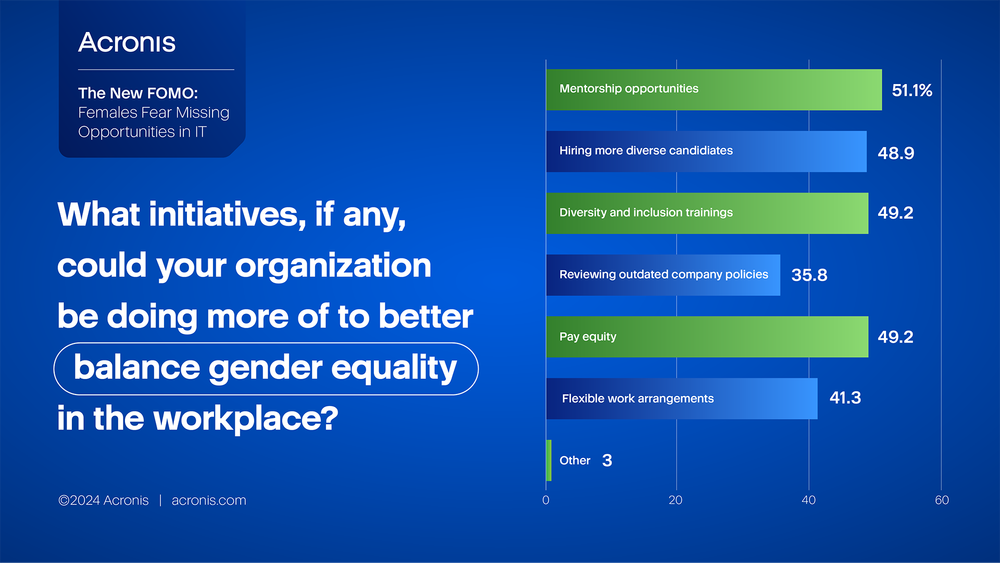
For women, progress in IT careers has proven to be both hard fought and slow, according to a global survey of female IT professionals conducted by Acronis.
While there are still few fields as notoriously male dominated as IT, women have made great strides. Nevertheless, there are paths women can take to further their careers, and there is some evidence to suggest that employers are making at least some effort toward achieving gender balance.
Women work harder but still face obstacles
Most notably, 71% of survey respondents said they worked longer hours with the goal of advancing their careers more quickly. Why? Largely because they still have to. Half of respondents said they had experienced gender bias or discrimination.

Almost two thirds said their workplaces weren’t doing enough to achieve gender equality. And 70% said men in IT were likely to advance their careers or receive promotions more quickly than women.
So, when will the professional environment for women in IT improve? Nearly one third of respondents said they believe women and men are treated equally in the workplace already. That’s the good news. The less encouraging news is that almost a quarter said equality would come in the next five years, and nearly 28% said it would take between 5 to 10 more years.
However, only about 4% said women would never be treated as equals, so most respondents seemed hopeful that they are, and will continue to be, effective in bringing about change.
The number of women in IT is higher than it might seem
Whatever inequalities exist, they’re not the result of lack of participation among women in IT. Half of respondents said their teams were between 25% and 50% female. Almost 17% said their departments were majority female, and in this global survey, a little more than a quarter of respondents said IT departments in their respective countries were just about balanced between men and women.
But relatively positive overall numbers haven’t necessarily translated to more female leadership in IT. Almost two in three respondents, or 63%, said there wasn’t enough female leadership in IT, and more than half said that lack of female leadership “bothered” them. In addition, 84% said their organizations would benefit from recruiting more women in leadership roles.

There was a positive sign to suggest that organizations are at least paying more attention to male-female balance, as 63% of respondents said their employers were doing enough to balance gender equality.
Gender diversity is a strategic advantage
There is strong evidence to suggest that incorporating gender diversity in hiring practices is a strategic advantage for businesses. The World Benchmarking Alliance found in 2023 that the global top 100 companies significantly outperformed lower-ranking operations by instituting policies to encourage gender equality.
Of the top 100 companies, 74% made a public commitment to gender equality compared to only 20% of the bottom 906 companies. Also, 59% of the top companies provide childcare and family support compared to 19% of other companies.
Along those same lines, 75% of the top 100 companies provide flexible working arrangements for their employees. Only one-third of lower-ranked companies do so. Women play an irreplaceable role in enabling organizations to grow and prosper by offering a unique set of skills. Companies that embrace gender diversity in hiring offer themselves an easily achievable but significant strategic advantage and competitive edge.
What can women do to bridge the gender gap?
So, what keeps women from pursuing IT careers? About 20% of respondents said lack of opportunity was the main reason women were “put off” of working in cybersecurity. By contrast, 25% cited focus on building a family. Another 9% said women avoided cybersecurity careers because they “wouldn’t fit in,” while 15% said women didn’t want to work in a male-dominated industry.
Take advantage of training and development opportunities
Still, opportunities for female advancement do exist. Fewer than 20% of respondents said their organizations lacked adequate training and career development for women, so the vast majority felt as though they had at least some opportunities from their employers to move forward at work. And taking advantage of those opportunities was one of the main action items respondents suggested.
When asked which activities were most important for women looking to further their careers, 63% of respondents suggested participating in master classes, courses or workshops. Almost half cited obtaining more education and credentials.
About 15% of respondents cited lack of confidence in ability or too many training and skills requirements as the main reason women avoided working in IT. Taking advantage of the training available through employers could go a long way toward resolving both issues.
Mentoring and networking
One strong thread that ran through the survey was a need for more female leadership in IT. Respondents said stepping up to mentor younger female employees is critical to career development.
Almost 14% said the main reason women didn’t enter IT was because of a lack of mentorship. Moreover, 29% of respondents said mentoring junior staff was critical to their own career advancement.
Along those same lines, a related “soft skill” respondents touted was networking. Almost 60% said networking — including participating in happy hours, team-building exercises and conferences — was important for advancement. And 44% cited the importance of joining professional organizations.
Highlighting accomplishments
Women are often less likely than men to self-promote at work. That’s a habit that women in IT should break. Respondents overwhelmingly reported tracking their accomplishments with the aim of advancing their careers. In fact, 60% said they record every accomplishment for future reference, while another 34% said they track just the “big wins.”
A significant percentage of respondents said women shouldn’t be afraid to look elsewhere if their employers aren’t recognizing their outstanding work, and almost 17% said job hopping was important for career advancement.
What can employers do to move toward gender equity?
Women have worked for decades to challenge male dominance in the workplace, particularly in IT. There is some indication that employers are now on board with helping them. But what can they do to continue moving in that direction?
Respondents offered some familiar but still often overlooked solutions. Almost half cited pay equity, and roughly the same number chose diversity and inclusion training. About 49% suggested actively hiring more diverse candidates, and flexible work arrangements were important to 41% of respondents.
Keeping with a leadership theme, 51% of respondents, the largest percentage responding to any of the choices provided, cited mentorship opportunities as something employers can do to move toward gender balance.

Gender equality in IT is a work in progress
Despite positive signs, women continue to face challenges in achieving gender equality in IT. Survey results show that the most effective steps they can take now are to take advantage of training opportunities, mentor young women and network. Making progress might still be a process that’s slower than it should be, but it is possible.
Methodology
Acronis commissioned this survey via a third-party vendor. The survey sampled 327 full-time female employees in the U.S., U.K., Spain and Switzerland.
About Acronis
A Swiss company founded in Singapore in 2003, Acronis has 15 offices worldwide and employees in 50+ countries. Acronis Cyber Protect Cloud is available in 26 languages in 150 countries and is used by over 21,000 service providers to protect over 750,000 businesses.



